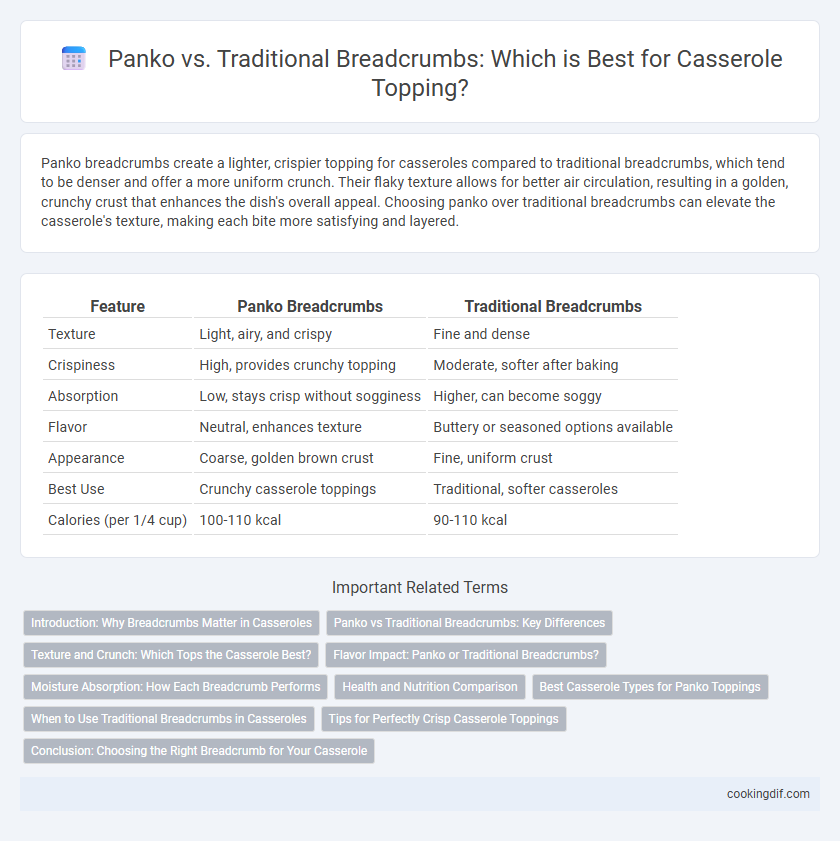Panko breadcrumbs create a lighter, crispier topping for casseroles compared to traditional breadcrumbs, which tend to be denser and offer a more uniform crunch. Their flaky texture allows for better air circulation, resulting in a golden, crunchy crust that enhances the dish's overall appeal. Choosing panko over traditional breadcrumbs can elevate the casserole's texture, making each bite more satisfying and layered.
Table of Comparison
| Feature | Panko Breadcrumbs | Traditional Breadcrumbs |
|---|---|---|
| Texture | Light, airy, and crispy | Fine and dense |
| Crispiness | High, provides crunchy topping | Moderate, softer after baking |
| Absorption | Low, stays crisp without sogginess | Higher, can become soggy |
| Flavor | Neutral, enhances texture | Buttery or seasoned options available |
| Appearance | Coarse, golden brown crust | Fine, uniform crust |
| Best Use | Crunchy casserole toppings | Traditional, softer casseroles |
| Calories (per 1/4 cup) | 100-110 kcal | 90-110 kcal |
Introduction: Why Breadcrumbs Matter in Casseroles
Breadcrumbs create a crucial crunchy layer in casseroles that enhances texture and flavor contrast. Panko breadcrumbs, known for their light, airy structure, provide a crispier and less greasy topping compared to traditional breadcrumbs, which tend to be denser and more compact. Choosing the right breadcrumb type directly affects the casserole's overall appeal and mouthfeel, making it essential to understand their unique properties.
Panko vs Traditional Breadcrumbs: Key Differences
Panko breadcrumbs offer a lighter, crispier texture compared to traditional breadcrumbs, which tend to be finer and denser, resulting in a crunchier casserole topping. Unlike traditional breadcrumbs, panko absorbs less oil, maintaining its crispiness even after baking, which is ideal for casseroles that benefit from a golden, crunchy finish. The larger, airier flakes of panko also promote better browning and a more visually appealing crust in casseroles.
Texture and Crunch: Which Tops the Casserole Best?
Panko breadcrumbs deliver a lighter, airier texture with an exceptional crunch that elevates casserole toppings, creating a crispier, more textured finish compared to traditional breadcrumbs. Traditional breadcrumbs tend to be denser and finer, producing a less pronounced crunch and a softer topping. For casseroles seeking a distinctly crispy, flaky crust, panko is the superior choice, enhancing both texture and mouthfeel.
Flavor Impact: Panko or Traditional Breadcrumbs?
Panko breadcrumbs provide a lighter, crispier texture and a mild flavor that enhances casserole toppings without overpowering the dish. Traditional breadcrumbs offer a denser, more uniform crunch with a richer, buttery taste that adds depth to casseroles. Choosing between panko and traditional breadcrumbs depends on whether a delicate crispiness or a robust, toasted flavor is desired to complement the casserole's ingredients.
Moisture Absorption: How Each Breadcrumb Performs
Panko breadcrumbs feature larger, flakier particles that absorb less moisture, resulting in a crispier casserole topping compared to traditional breadcrumbs. Traditional breadcrumbs, being finer and denser, soak up more moisture from the casserole, often producing a softer, less crunchy crust. Choosing panko enhances texture retention by maintaining a crunchy exterior even when exposed to the casserole's moisture during baking.
Health and Nutrition Comparison
Panko breadcrumbs offer a lighter, airier texture with fewer calories and less fat compared to traditional breadcrumbs, making them a healthier choice for casserole toppings. Traditional breadcrumbs typically contain higher sodium levels and may include added preservatives, which can negatively impact heart health. Choosing panko enhances nutritional value by reducing saturated fat intake and supporting weight management without sacrificing the crispiness of the casserole crust.
Best Casserole Types for Panko Toppings
Panko breadcrumbs create a light, crispy topping ideal for casseroles like green bean casserole, mac and cheese, and chicken divan, offering a crunchy texture that contrasts with creamy fillings. Traditional breadcrumbs tend to absorb more moisture, resulting in a denser, less crispy crust better suited for hearty casseroles such as shepherd's pie or meatloaf casseroles. Panko's airy structure enhances casseroles with delicate ingredients and creamy sauces, making it the best choice for dishes requiring a golden, crisp finish.
When to Use Traditional Breadcrumbs in Casseroles
Traditional breadcrumbs create a denser, moister topping for casseroles, making them ideal when a softer, more uniform crust is desired. They absorb sauces and cheese well, enhancing the overall texture and preventing the topping from drying out. Use traditional breadcrumbs in casseroles with creamy or wetter fillings to maintain a cohesive, tender layer instead of a crispy, crunchy finish.
Tips for Perfectly Crisp Casserole Toppings
Panko breadcrumbs create a lighter, crispier topping for casseroles due to their coarser texture and larger flakes, which allow better air circulation and browning. Traditional breadcrumbs tend to produce a denser, softer crust, which may be desirable for a heartier finish but less ideal for a crunchy top. For perfectly crisp casserole toppings, toast panko lightly in butter before sprinkling to enhance flavor and achieve an even golden-brown crust.
Conclusion: Choosing the Right Breadcrumb for Your Casserole
Panko breadcrumbs create a lighter, crunchier topping that enhances casserole textures without overwhelming the dish, making them ideal for casseroles needing a crisp contrast. Traditional breadcrumbs provide a denser, more uniform crust that complements creamy or hearty casseroles by absorbing flavors and adding moisture retention. Selecting panko or traditional breadcrumbs depends on the desired texture and moisture balance to achieve the perfect casserole topping.
Panko vs Traditional breadcrumbs for casserole topping Infographic

 cookingdif.com
cookingdif.com